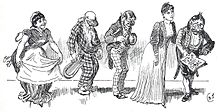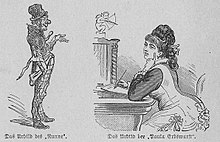Joke
Ulk was the title of a German satire magazine published by Rudolf Mosse Verlag . The full name was: Ulk. Illustrated weekly paper for humor and satire. The magazine was published from 1872 to 1922 as an increasing circulation free supplement on Thursdays in the Berliner Tageblatt . At the same time, the joke was added to the Berliner Volks-Zeitung between 1910 and 1922 . From 1922 the paper appeared as an independent publication . After the economic collapse of the Mosse Group , production of the magazine was gradually discontinued from autumn 1932.
useful information
The illustrated weekly paper for humor and satire was founded on April 3, 1872 by Rudolf Mosse and Siegmund Haber . It was supposed to be a North German counterpart to the South German Fliegende Blätter . The abbreviation "ULK" stands for the three departments "nonsense, carelessness and Kneipsinn" of the society ULK, which was founded in Haspe in 1857, a well-known satirical association at the time.
As editor-in-chief, Siegmund Haber determined the style of the paper until 1895. He designed the figures of the "corner stallion Nunne", the " Mamsell Paula Erbswurst" and "Mrs. Rentier Schladeberg", all of whom commented regularly on current political and social issues. After Haber's death, long-time employee Richard Schmidt-Cabanis became editor -in- chief, who represented the characters of the “Jeheimrats-Jette”, the “blind seer” and the “Dr. Joke ”introduced. During this time, the joke was significantly involved in the clashes of the Kulturkampf , in which he regularly fueled the debate again until 1900 with inflammatory poems, alleged revelations and anti-Catholic caricatures, although the dispute was officially ended in 1878 and diplomatically settled in 1887.
From 1912 the joke was printed in color. The circulation always roughly corresponded to the circulation of the Berliner Tageblatt and the Berliner Volks-Zeitung . Concrete information on this is not possible because there were no official surveys until 1933 and it can be shown that the company's own statistics at Mosse were very generous. It can be proven that the edition of the Ulk reached its peak on the eve of the First World War , declined from 1916, fluctuated greatly during the Weimar period and fell extremely from 1928.
On November 22, 1907, the first journalistic work by the satirist and political critic Kurt Tucholsky was published in Ulk under the title Fairy Tales anonymously , in which the 17-year-old parodied Kaiser Wilhelm II's taste in art . From December 1918 to April 1920 Tucholsky worked as editor- in- chief at Ulk and often published his articles under the pseudonym Theobald Tiger . From 1919 he got increasingly at odds with Theodor Wolff , the influential editor-in-chief of the Berliner Tageblatt , who sought a unilateral politicization of all Mosse papers in favor of the German Democratic Party and even sold election programs of this party in a joke . Because the relationship cooled down more and more, Tucholsky resigned on April 1, 1920 and in a disparaging retrospective described Theodor Wolff as a condescending, “somewhat stupid man” with “supposedly so liberal” but one-sided principles.
The new editor-in-chief was Josef Wiener-Braunsberg, who continued Theodor Wolff's desired line. The party-related one-sidedness or satirical imbalance also met with increasing criticism from Hans Lachmann-Mosse , who had taken over the management of the company in 1920 and foresaw a decrease in circulation with an increasingly divergent readership. Because from 1926 onwards the Berliner Tageblatt could only make losses, the Ulk was temporarily added to the Berliner Tageblatt as a free supplement . This countermeasure in turn led to a loss of income and advertising in the ulcer . Following Wolff's intentions, Hermann Sinsheimer took over as editor-in-chief in November 1929 . This not only entailed a new layout , but also Theodor Wolff's wish for even greater politicization.
At this point in time, the publisher's house bank had long since indicated an impending insolvency . Lachmann-Mosse tried by all means to turn things around, but met with little understanding, especially from Wolff, with cost-cutting measures and requests for changes in content. At the end of June 1931, Hans Lachmann-Mosse had long-term employee Hans Flemming come to him and demanded his word of honor not to speak to Theodor Wolff or anyone else about the interview; He openly explained the economic situation of the company and said: "You will take over the Ulk editor-in-chief from July 1, 1931, put him on the political back burner and if we do not make a profit within twelve months, we will discontinue the paper". Flemming gave him his word of honor.
Accordingly, on July 1, 1931, Sinsheimer was replaced by Hans Flemming. Savings followed throughout the publishing house, such as fee reductions, the closure of agencies at home and abroad, the omission of inserts and color printing, and a reduction in the number of pages. Many young and good employees left of their own accord. When long-serving colleagues were about to be laid off, the workforce took strike action . The economic collapse of the Mosse Group took place in 1932. All countermeasures were taken too late, and bankruptcy proceedings had to be opened on September 13, 1932 . Around 8,000 creditors filed their claims.
Unclarities last issue
When exactly the last issue of the satirical magazine appeared is currently unknown. What is certain is that from 1931 the joke was only printed irregularly and no longer in color, and that in some cases it was only distributed as a one-sided insert. In the literature, the date of employment is mostly mentioned as September 13, 1932, which seems likely due to the bankruptcy opening and the associated wave of layoffs. Likewise, there are no entries in the Central Directory of Antiquarian Books for the joke after 1932. On the other hand is in the catalog German national library in inventory contradictory listed the year 1933 and the last publication date of the 10th or March 11, 1934. However, this date should mean the final transfer of the insolvent Rudolf Mosse OHG to the Berliner Druck- und Zeitungsbetriebe AG, which was founded on March 11, 1934 as a special rescue company . The complete editions of the joke from 1901 to 1930 are available in digitized form online at the Heidelberg University Library .
Known employees (selection)
- Victor Auburtin
- Hans Brennert
- Sigmar Mehring
- Hans Reimann
- Ewald Gerhard Seeliger
- Hans Heinrich von Twardowski
- Hermann Abeking
- Lyonel Feininger
- Josef Fenneker
- George grosz
- August Hajduk
- Walter Herzberg
- Karl Holtz
- Jesekiel David Kirszenbaum
- Willibald Krain
- Alfred Kubin
- Ernst Lübbert
- Jeanne Mammen
- Frans Masereel
- Erich Mühsam
- Rolf Niczky
- Käthe Olshausen-Schönberger
- Albert Schaefer-Ast
- Hermann Scherenberg '
- Rudolf Schlichter
- Paul Simmel
- Ottomar Starke
- Ernst Stern
- Walter Trier
- Jupp Wiertz
- Hermann Wilke
- Heinrich Zille
literature
- Peter de Mendelssohn : Berlin newspaper city. People and Powers in the History of the German Press Berlin. Ullstein, 1959. Second, revised and expanded edition. Ullstein, Berlin 1982, ISBN 3-550-07496-4 .
- Ursula E. Koch : The devil in Berlin. From the March Revolution to Bismarck's dismissal. Illustrated political joke sheets of a metropolis 1848–1890. (with a view). informationspresse-cwleske Verlag, Cologne 1991, ISBN 3-921490-38-3 .
- Klaus Haese , Wolfgang U. Schütte: Ms. Republic goes bankrupt. German caricatures of the twenties. Edition Leipzig, Leipzig 1989, ISBN 3-361-00251-6 .
- Elisabeth Kraus: The Mosse family: German-Jewish bourgeoisie in the 19th and 20th centuries. CH Beck, Munich 1999.
- Norbert Frei, Johannes Schmitz: Journalism in the Third Reich. CHBeck, Munich 2011.
Web links
Individual evidence
- ↑ Bernd A. Gülker: The distorted modernity. The caricature as a popular art criticism in German satirical magazines. LIT Verlag, 2001. p. 258.
- ^ Staatsbibliothek Berlin: Get the result in a flash. Historical newspaper treasures. P. 4. http://staatsbibliothek-berlin.de/fileadmin/user_upload/zentrale_Seiten/katalogsystem_wd/dokumente/e-day/eday_15_HO_histor.Zeitungen.pdf
- ^ Paul Schulte: The history of the world famous society ULK in Haspe ; published in Hasper Heimatblätter , 1928
- ↑ As early as 1868, Die Gartenlaube reported on pages 613–615 in a three-page “report” (drawn by FB) about the ULK company in Haspe. ( Wikisource )
- ↑ Manuel Borutta: Anti-Catholicism: Germany and Italy in the age of European cultural struggles. Vandenhoeck & Ruprecht, 2011. p. 193.
- ^ Clemens Zimmermann, Manfred Schmeling: Die Zeitschrift - Medium der Moderne. Transcript Verlag, 2015. p. 166.
- ^ Otto Altendorfer, Ludwig Hilmer: Media Management: Volume 2: Medienpraxis. Media history. Media regulations. Springer-Verlag, 2015. p. 164.
- ^ Elisabeth Kraus: The Mosse family: German-Jewish bourgeoisie in the 19th and 20th centuries. CH Beck, 1999. pp. 470 f.
- ^ Friedhelm Greis, Ian King: Tucholsky and the media: Documentation of the 2005 conference: "We live in a strange newspaper". Röhrig Universitätsverlag, 2006. pp. 21–27.
- ↑ Michael Hepp: Kurt Tucholsky. Rowohlt Verlag, 2015. p. 134.
- ^ Peter de Mendelssohn: Berlin newspaper city. People and Powers in the History of the German Press Berlin. Ullstein, 1959. pp. 89 f.
- ^ Siegfried Jacobsohn, Kurt Tucholsky, Richard von Soldenhoff: Letters to Kurt Tucholsky, 1915-1926. Knaus, 1989. p. 366.
- ^ Norbert Frei, Johannes Schmitz: Journalism in the Third Reich. CH Beck, 2011. p. 41.
- ^ Elisabeth Kraus: The Mosse family: German-Jewish bourgeoisie in the 19th and 20th centuries. CH Beck, 1999. p. 513
- ↑ Bernd A. Gülker: The distorted modernity. The caricature as a popular art criticism in German satirical magazines. LIT Verlag, 2001. p. 258.
- ^ Entry in the catalog of the German National Library
- ↑ Ulk. Illustrated weekly paper for humor and satire (1914–1930) (Heidelberg University Library)


